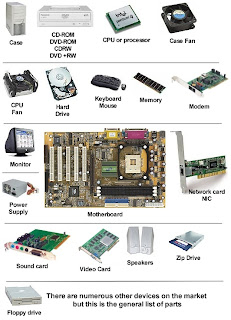PARTS OF A COMPUTER
~ MONITOR ~
- A monitor displays information in visual form, using text and graphics.
- The portion of the monitor that displays the information is called the screen. Like a television screen, a computer screen can show still or moving pictures.
- There are two basic types of monitors: CRT (cathode ray tube) monitors and LCD (liquid crystal display) monitors.
- Both types produce sharp images, but LCD monitors have the advantage of being much thinner and lighter. CRT monitors, however, are generally more affordable.
~ MODERM ~
- To connect your computer to the Internet, you need a modem.
- A modem is a device that sends and receives computer information over a telephone line or high-speed cable.
- Modems are sometimes built into the system unit, but higher-speed modems are usually separate components.
~ SYSTEM UNIT ~
- The system unit is the core of a computer system.
- Usually it's a rectangular box placed on or underneath your desk. Inside this box are many electronic components that process information.
- The most important of these components is the central processing unit (CPU), or microprocessor, which acts as the "brain" of your computer.
- Another component israndom access memory (RAM), which temporarily stores information that the CPU uses while the computer is on. The information stored in RAM is erased when the computer is turned off.
- Almost every other part of your computer connects to the system unit using cables.
- The cables plug into specific ports (openings), typically on the back of the system unit. Hardware that is not part of the system unit is sometimes called a peripheral device ordevice.
~ MOUSE ~
- A mouse is a small device used to point to and select items on your computer screen. Although mice come in many shapes, the typical mouse does look a bit like an actual mouse.
- It's small, oblong, and connected to the system unit by a long wire that resembles a tail. Some newer mice are wireless.
- A mouse usually has two buttons: a primary button (usually the left button) and a secondary button.
- Many mice also have a wheel between the two buttons, which allows you to scroll smoothly through screens of information.
- When you move the mouse with your hand, a pointer on your screen moves in the same direction. (The pointer's appearance might change depending on where it's positioned on your screen) .
- When you want to select an item, you point to the item and then click (press and release) the primary button. Pointing and clicking with your mouse is the main way to interact with your computer
~ SPEAKERS ~
- Speakers are used to play sound.
- They may be built into the system unit or connected with cables.
- Speakers allow you to listen to music and hear sound effects from your computer.
~ PRINTER ~
- A printer transfers data from a computer onto paper.
- You don't need a printer to use your computer, but having one allows you to print e‑mail, cards, invitations, announcements, and other materials.
- Many people also like being able to print their own photos at home.
- The two main types of printers are inkjet printers and laser printers. Inkjet printers are the most popular printers for the home.
- They can print in black and white or in full color and can produce high-quality photographs when used with special paper.
- Laser printers are faster and generally better able to handle heavy use.
~ KEYBOARD ~
- A keyboard is used mainly for typing text into your computer. Like the keyboard on a typewriter, it has keys for letters and numbers, but it also has special keys .
- The function keys, found on the top row, perform different functions depending on where they are used.
- The numeric keypad, located on the right side of most keyboards, allows you to enter numbers quickly.
- The navigation keys, such as the arrow keys, allow you to move your position within a document or webpage.

























